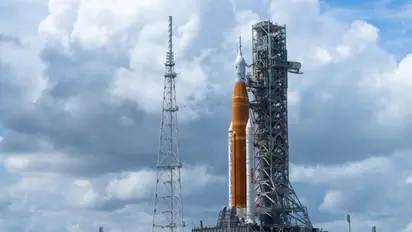NASA calls off second attempt to launch moon rocket after Artemis-1 suffers fuel leak

Synopsis
The second attempt to launch the Artemis-1 mission to the Moon was scrubbed as well after leaks were detected in the world's most powerful rocket. The $4.1 billion test flight is the first step in NASA’s Artemis program of renewed lunar exploration, named after the twin sister of Apollo in Greek mythology.
The second attempt by NASA was similarly aborted hours before the launch window opened — this time owing to a leak that formed in the supply side of the eight-inch fast disconnect — days after an engine failure prompted the space agency to defer the launch of its ambitious Artemis mission. The launch preparation had initially begun by loading nearly a million gallons of fuel into the 322-foot (98-meter) rocket. The tanking process had to be momentarily stopped due to an over-pressure alert, but no harm was done as a result, so work could continue.
A few minutes later, engineers discovered hydrogen fuel seeping from the rocket's engine section, prompting them to cease filling and start debugging. It was believed to be a gap around a seal in the supply line as the countdown clock remained active.
"Engineers are continuing troubleshooting efforts to address a liquid hydrogen leak in a cavity in the quick disconnect where the flight side and ground side plates join. They once again will attempt to warm up the quick disconnect to try to reset the seal," NASA said in an update before scrubbing the launch.
Also Read | NASA reshares eerie and haunting sound of a black hole; lIsten here
The leak was different from the one that was found on Monday. On Monday, the scientists discovered a hydrogen leak on a purge can-related part of the tail service mast quick connection. They manually adjusted propellant flow rates to stop the leak. A sensor on Monday showed one of the rocket's four engines was too warm, but engineers subsequently confirmed it was really cool enough, which created an even bigger issue. This time, the launch crew intended to disregard the defective sensor and depend on other equipment to verify that each main engine was sufficiently cooled.
The $4.1 billion test flight is the first phase of NASA's Artemis mission, which is named after Apollo's twin sister from Greek mythology and aims to restart lunar exploration. During NASA's Apollo programme, twelve men made the last moonwalk in 1972. The American space agency is not in the mood to take any chances by launching a flawed rocket as it seeks to create a prolonged human presence on the moon, with personnel eventually spending weeks at a time there, even if the project is already behind schedule.
Also Read | James Webb telescope captures 'incredible' photos of Jupiter; Check out